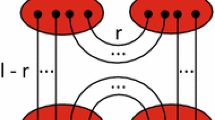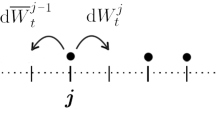Abstract
We consider a two-component asymmetric simple exclusion process (ASEP) on a finite lattice with reflecting boundary conditions. For this process, which is equivalent to the ASEP with second-class particles, we construct the representation matrices of the quantum algebra \(U_q[\mathfrak {gl}(3)]\) that commute with the generator. As a byproduct we prove reversibility and obtain in explicit form the reversible measure. A review of the algebraic techniques used in the proofs is given.
Similar content being viewed by others
Notes
The occupation numbers can be formally regarded as families of mappings \(a_k: \mathbb {S}^L \mapsto \{0,1\}\), \(b_k: \mathbb {S}^L \mapsto \{0,1\}\) and should thus be understood as functions \(a_k(\eta )\), \(b_k(\eta )\) of \(\eta \). Since the functional argument \(\eta \) will always be clear from context [as is the case e.g. in (4)], we do not write it explicitly. However, we shall usually write explicitly the argument for the particle number functions \(N(\eta )\), \(M(\eta )\) to contrast them with their numerical values N, M.
We shall use interchangeably the arguments \(\eta \), \(\mathbf {z}\), \(\{\mathbf {x},\mathbf {y}\}\) for functions of the configurations. When the argument is clear from context it may be omitted.
We shall usually omit the set \(\mathbb {S}^L\) in the summation symbol and simply write \(\sum _{\eta }\).
The connection to integrable models, in particular the parameter dependence of R, the construction of the associated statistical mechanics transfer matrix, and its quantum Hamiltonian limit, is not important for the purposes of this work. We refer the interested reader to [10, 11, 19] for more details and to [2] for an introduction to the field.
References
Alcaraz, F.C., Rittenberg, V.: Reaction–diffusion processes as physical realizations of Hecke algebras. Phys. Lett. B 314, 377–380 (1993)
Baxter, R.J.: Exactly Solved Models in Statistical Mechanics. Academic, New York (1982)
Belitsky, V., Schütz, G.M.: Self-duality for the two-component asymmetric simple exclusion process. arXiv:1504.05096 (2015)
Burdík, Č., Havlíček, M., Vančura, A.: Irreducible highest weight representations of quantum groups \(U(gl(n,{\mathbb{C}}))\). Commun. Math. Phys. 148(2), 417–423 (1992)
Burroughs, N.: The universal R-Matrix for \(U_qsl(3)\) and beyond!. Commun. Math. Phys. 127, 109–128 (1990)
Derrida, B., Janowsky, S.A., Lebowitz, J.L., Speer, E.R.: Exact solution of the totally asymmetric simple exclusion process: shock profiles. J. Stat. Phys. 73, 813–842 (1993)
Evans, M.R., Ferrari, P.A., Mallick, K.: Matrix representation of the stationary measure for the multispecies TASEP. J. Stat. Phys. 135(2), 217–239 (2009)
Ferrari, P.A., Martin, J.B.: Stationary distributions of multi-type totally asymmetric exclusion processes. Ann. Probab. 35(3), 807–832 (2007)
Ferrari, P.A., Kipnis, C., Saada, E.: Microscopic structure of travelling waves in the asymmetric simple exclusion process. Ann. Probab. 19(1), 226–244 (1991)
Jimbo, M.: A \(q\)-analogue of \(U(\mathfrak{gl}(N + 1))\), Hecke Algebra, and the Yang–Baxter equation. Lett. Math. Phys. 11, 247–252 (1986)
Jones, V.R.F.: Baxterization. Int. J. Mod. Phys. B 4(5), 701–713 (1990)
Liggett, T.M.: Interacting Particle Systems. Springer, Berlin (1985)
Liggett, T.M.: Stochastic Interacting Systems: Contact, Voter and Exclusion Processes. Springer, Berlin (1999)
Lloyd, P., Sudbury, A., Donnelly, P.: Quantum operators in classical probability theory: I “Quantum spin” techniques and the exclusion model of diffusion. Stoch. Process. Appl. 61(2), 205–221 (1996)
Martin, P.P., Rittenberg, V.: A template for quantum spin chain spectra. Int. J. Mod. Phys. A 7(Suppl. 1B), 707–730 (1992)
Perk, J.H.H., Schultz, C.L.: New families of commuting transfer matrices in \(q\)-state vertex models. Phys. Lett. 84A, 407–410 (1981)
Prolhac, S., Evans, M.R., Mallick, K.: Matrix product solution of the multispecies partially asymmetric exclusion process. J. Phys. A Math. Gen. 42, 165004 (2009)
Sandow, S., Schütz, G.: On \(U_q[SU(2)]\)-symmetric driven diffusion. Europhys. Lett. 26, 7–12 (1994)
Schultz, C.L.: Solvable q-state models in lattice statistics and quantum field theory. Phys. Rev. Lett. 46, 629–632 (1981)
Schütz, G.M.: Duality relations for the asymmetric exclusion process. J. Stat. Phys. 86(5/6), 1265–1287 (1997)
Schütz, G.M.: Exactly solvable models for many-body systems far from equilibrium. In: Domb, C., Lebowitz, J. (eds.) Phase Transitions and Critical Phenomena, vol. 19, pp. 1–251. Academic Press, London (2001)
Acknowledgments
This work was supported by DFG and by CNPq through the Grant 307347/2013-3. GMS thanks the University of São Paulo, where part of this work was done, for kind hospitality.
Author information
Authors and Affiliations
Corresponding author
Appendix
Appendix
We display some explicit results for unnormalized stationary distributions for small lattices \(L=2,3,4\) and also L arbitrary with small particle numbers \(N+M = 1,2,3,4\).



\(\underline{N+M=1:}\)
\(\underline{N+M=2:}\)
\(\underline{N+M=3:}\)
\(\underline{N+M=4:}\)
Rights and permissions
About this article
Cite this article
Belitsky, V., Schütz, G.M. Quantum Algebra Symmetry of the ASEP with Second-Class Particles. J Stat Phys 161, 821–842 (2015). https://doi.org/10.1007/s10955-015-1363-1
Received:
Accepted:
Published:
Issue Date:
DOI: https://doi.org/10.1007/s10955-015-1363-1




